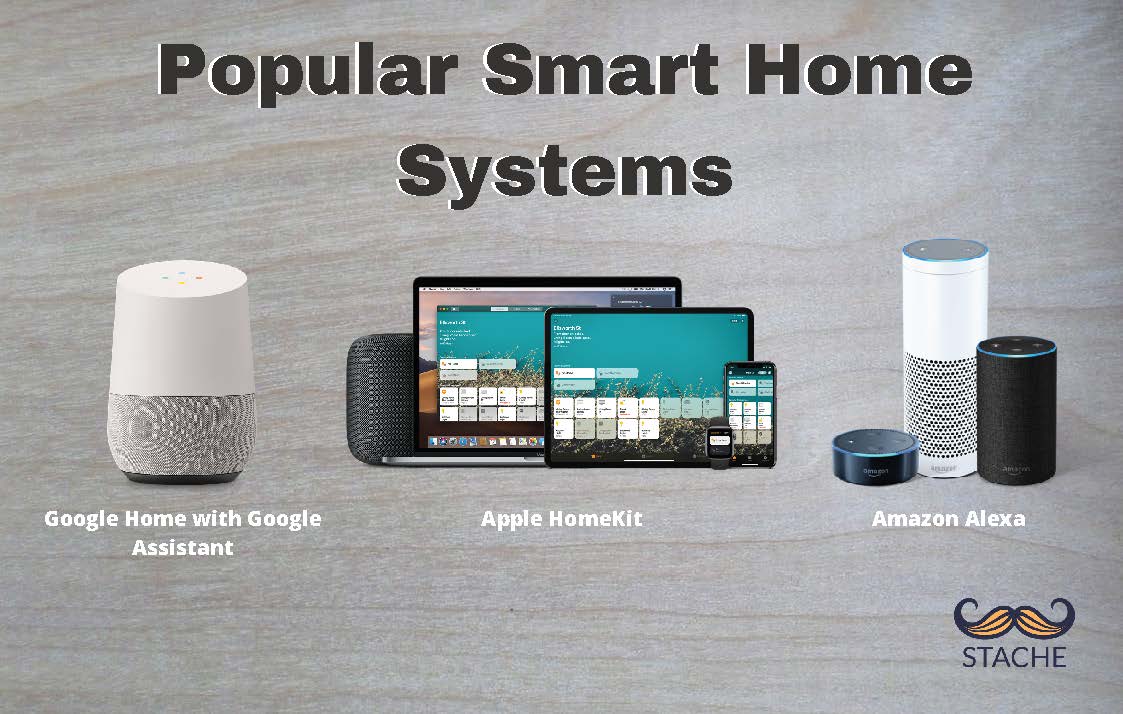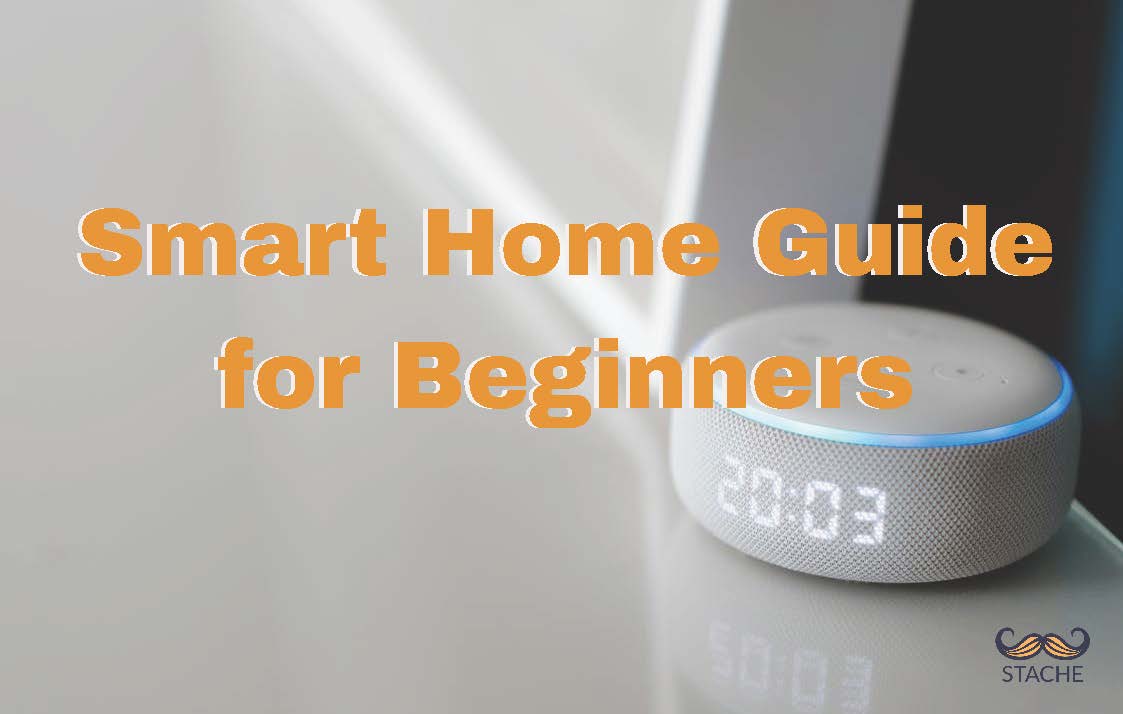It’s 7AM, and I am gently awoken by the lamp on my nightstand gradually becoming brighter. Thirty minutes ago, the temperature in my house began a slow increase to my preferred 68º after a cold night.
I don’t hear a loud, jarring alarm, but I can smell a fresh cup of coffee brewing in the kitchen. As I get out of bed, a voice coming out of my speaker tells me today’s weather and news headlines.
This is the ultra-convenient, modern reality of living with a smart home system.
What is a smart home?
A smart home is simply any home in which the lighting, heating, and/or other electronic devices can be remotely controlled by a phone or computer.
In my house, I set up a smart thermostat (for heating and cooling), smart speakers, smart light bulb, and I connected my simple coffee maker to a smart plug. By using these products and services, I can easily set up my morning routine from my smartphone.
How to make your home a smart home
A smart home is made up of smart devices (e.g. a smart thermostat) that all connect to your smart home system of choice (e.g. Amazon Alexa).
To make your home a smart home, all you have to do is buy smart products (devices that connect to wifi) and a smart home system. Once you have these things, you can easily set up home automation for super modern living.

Smart home systems
You should start by choosing which smart home system you want to connect all of your smart home devices to, since which devices you purchase will depend on the system you choose.
The most popular smart home systems are Google Home with Google Assistant, Apple HomeKit, and Amazon Alexa (used with speakers like an Amazon Echo).
These smart home systems all work pretty similarly. They connect to smart devices and can be controlled from a phone, computer, or even through voice commands. It’s just a matter of your personal preference.
Smart home devices
Depending on your needs and interests, there is cutting-edge gear just for you. Some popular ones include:
- A smart thermostat: (e.g. the Nest thermostat or Ecobee SmartThermostat, $249.99): In my house, we like to save energy by turning down the heat at night while we’re sleeping. So, I’ve used my smart thermostat to set the temperature to gradually rise starting 30 minutes before my alarm clock goes off in the morning. That way, I don’t have to get out of my warm cozy bed and be shocked by the cold air. You can schedule temperature changes however you like.
- Smart TVs: Smart televisions connect to the internet so that you can access all of your content platforms (Netflix, Hulu, Amazon Prime, Disney+, etc). You can also command actions through voice control or gesture recognition for easy control.
- Smart light bulbs: (e.g. Philips Hue light bulbs, starter kit $69.99) Smart light bulbs will take your home lighting to a new level. With some smart light bulbs, you can change the color of the lighting. With others, you can change the brightness. Imagine having a romantic dinner and dimming the lights from your phone, or being stuck on a Zoom call and needing to make the lighting brighter without getting up. These are all things you can do from your phone with smart light bulbs.
- Smart light switches: These can be even easier than light bulbs because they can be controlled from your phone whether or not the physical light switch is turned on. With a smart light bulb, the light switch must be physically turned on (i.e. you need to get up and turn it on) in order to begin to control the color or brightness. However, if your light switch is smart, then you can turn the light on and off from your phone. You can even take these smart light systems one step further and have them able to detect when someone is in the room or not and adjust the lighting accordingly.
- Smart locks and door openers: With these, you can grant access to visitors or family members from your phone, or have them detect when you are close to a door and automatically unlock it. You can also lock doors while you’re not home, which is a huge convenience for safety purposes.
- Smart security cameras: These can include doorbell cameras and other home security cameras, all of which can be controlled from your home. Maybe you’re out to dinner and you can’t remember if you turned the home security system on before you left – that’s no longer a problem because you can turn it on from your phone while at dinner. Or maybe you’re waiting for a package to arrive but you’re not at home, and you want to quickly check if it’s there – just open your phone and check the security camera on your front porch.
- Smart plugs: With smart plugs, a sort of general smart device, you can turn any simple device with an on/off switch into a smart device. For example, do you have a coffee maker that makes coffee just by pressing the on button? Plug that coffee maker into a smart plug and now you can control it from your phone.
- Watering devices: There are plenty of smart devices that help you water your plants or even your lawn on scheduled times. These devices often also help optimize efficiency and use less water but still obtain the same results in terms of plant health and growth.
- Household system monitors: Another option to help improve home safety is a household system monitor, which has the ability to detect things like water failures/freezing pipes and turn off the water so your house doesn’t flood, or prevent an electrical surge.
Make sure that when you are considering purchasing a tech savvy product that it is compatible with the smart home system you have selected.
Smart home pros
Without a doubt one of the biggest advantages to having home automation is peace of mind – homeowners can monitor their homes from their phones, no matter where they are. Some potential dangers that can be mitigated by remotely controlled smart devices include:
- A device accidentally left on
- A door left unlocked or an alarm system left off
- Elderly people being left alone without any way to monitor them
Apart from safety, the other clear advantage of having a smart home is the convenience it will bring to your life. Not only can you control devices from your phone, but you can program them ahead of time to make things happen automatically.
For example, you can your garage door automatically open when you approach your home, or you can have the lights change settings throughout the day based on the time of day.
One last added bonus of all of this home automation is increased efficiency. Air conditioning and heating require a lot of energy, but smart home systems can learn your behaviors and learn how to optimize both AC and heating so that you’re completely comfortable but wasting less energy.
Smart home cons
Although we’ve been focusing on all of the benefits of a smart home, there are certainly drawbacks as well. Here are some of the barriers to having a smart home:
- Price: smart products and services aren’t always cheap, and they can quickly add up to a big cost.
- Technical barrier: although the things you can do with all of these smart devices are incredibly useful, there is definitely a learning curve to figuring out how to use them. Some people will become frustrated while setting up their devices or trying to program them. While the user interface tends to be pretty intuitive, you will still need some patience.
- Security: many consumers worry about the security of all of this data – after all, your smart home product could be collecting very detailed data about your lifestyle and behaviors in order to provide you with the best experience. The privacy and security of this data is of the utmost concern to consumers.
- Good wifi needed: all of the systems we discussed rely on the presence of strong, reliable wifi. If your wifi is shaky, the devices will no longer function as intended. Therefore, you’ll need to make sure your home has a stellar wifi connection.
After weighing the pros and cons, you can make a decision that’s best for you and your family. If you do choose to turn your home into a smart home, there’s no doubt you’ll feel like you’re living in the future.

